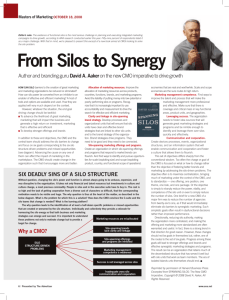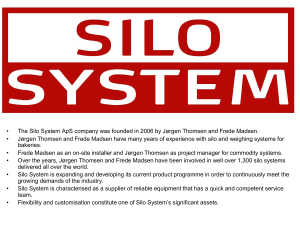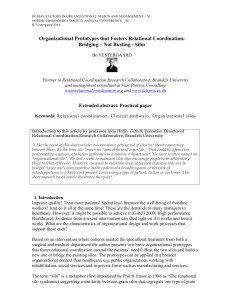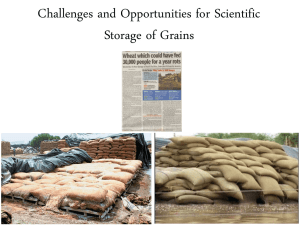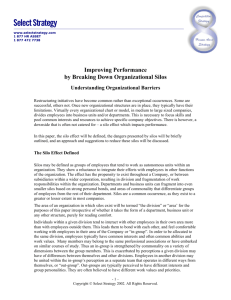Reinforcement and thickness calculation AHMAD
advertisement
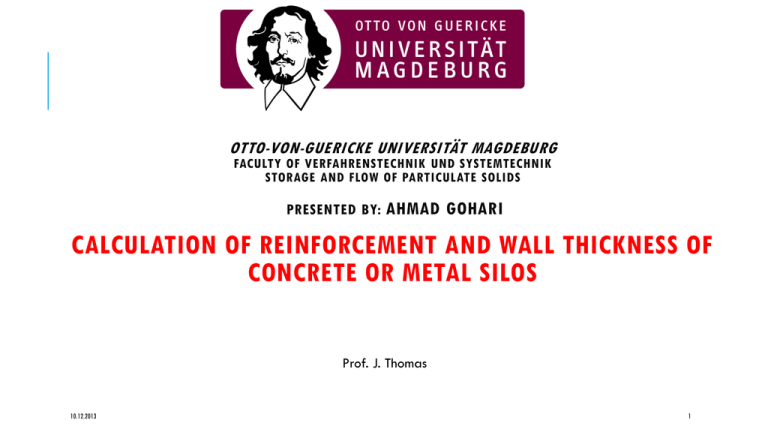
OTTO-VON-GUERICKE UNIVERSITÄT MAGDEBURG
FACULTY OF VERFAHRENSTECHNIK UND SYSTEMTECHNIK
STORAGE AND FLOW OF PARTICULATE SOLIDS
PRESENTED BY: AHMAD GOHARI
CALCULATION OF REINFORCEMENT AND WALL THICKNESS OF
CONCRETE OR METAL SILOS
Prof. J. Thomas
10.12.2013
1
TABLE OF CONTENTS
1. Introduction
1.1. Why pressure in Silo Matter?
1.2. Pressure in Silo, basic theory
2. Wall thickness calculation
3. The importance of flow patterns during discharge
3.1. Eccentric discharge and its consequence
4. Structural damage and its cause, Reinforcment
4.1. Steel and Aluminium Silo (metal)
4.2. Concret Silos
4.3. Reinforcement
5. Summary
10.12.2013
2
1. INTRODUCTION
1.1 Why pressure in Silo Matter?
Pressure in Silo is dominated by Frictional Phenomena
There are many misleading on pressure calculating ,
not unerstanding the condition of stress nor the
condiction which leads to failure
Mteal and concrete Silos behave very different,
different crictical consideration should be take on
account (speak about it at 3.1)
10.12.2013
3
1.2. PRESSURE AND TENSTION IN SILO, BASIC
THEORY
𝑞 + dq + 𝑈𝜏𝑑𝑧 = 𝑞𝐴 + 𝜌𝑏 𝐴𝑑𝑧
𝑃 = 𝑃0 (1 − 𝑒
−𝑧
𝑧0
)
Note: A
smooth
wall
leads to
higher
pressure
than a
rough
wall
𝑅
𝑍0 = 2µ𝐾
𝑏 .𝑅
𝑃0 = 𝜌2µ
𝑞 Horizontal pressure (N/m²)
𝑈 Premeter (m)
𝜏 Shear Stress (N/m²)
A slice of the wall
𝜌𝑏 Bulk density of material (kg/m³)
𝑧 Height (m)
µ10.12.2013
smoothness of wall
4
JANSSEN PRESSURE PATERN
10.12.2013
5
PRESSURE IN HOPPERS
𝑥
𝑛
𝑃 = 𝐹[𝑞𝑡 ( )𝑛 +
𝜌𝑏 𝐻
𝑛−1
𝑥
𝑛
𝑥
𝑛
{( )-( )𝑛 }]
𝑛 = 2𝐹 𝐹 + 𝐹𝜇ℎ 𝑐𝑜𝑡𝛽 − 1 the value of n is just a
number, simplification
𝐹 depends on geometry and solid properties, can be
seen in particular graphs
Notes:
1.Most structure failures occure by rapture at transition under the
stress resultamt 𝑛𝜃
2. The most critical feature of a hooper is not the wall pressure
distribution but the over equilibrium
10.12.2013
6
SIMPLE STRUCTURE CONSEPT FOR SHAFT
10.12.2013
7
PRESSURE CHANGES DURING DISCHARGE OF
SOLIDS (EMPTYING)
Force increase in horizontal direction
Force increase in vertical direction
Note: Kp/Kf at first considered to be order of 9 and then 6, this much pressure increase had
been never reported before, several theories (Arnold 1980, Jenke 1973) showed that Kp/Kf
should be around 2.5
10.12.2013
8
PRESSURE CHANGES DURING DISCHARGE OF
SOLIDS (EMPTYING)
Note: The most critical
finding for silo design
was the pattern of
unsymmetrical pressures,
both after filling and
during discharge. The
ratio of the largest
sustained pressure to the
smallest at a single level
could be high as 2.8
under static condiction
after filling and 5.6
during discharge
Pieper & Wentzel 1964, in Braunschweig, much of the following comes from their work
10.12.2013
9
2. THICKNESS CALCULATION
10.12.2013
10
2. THICKNESS CALCULATION
10.12.2013
11
PARAMETES AND COEFICIENTS WE NEED FOR
CALCULATION
10.12.2013
12
3. THE IMPORTANCE OF FLOW PATTERN
A modern describtion (EN 1991-4 2007) divides the possible flow pattern into three main
categories under symetrical condition
10.12.2013
13
3. THE IMPORTANCE OF FOLW PATTERN
Note: Structural researche studies have
shown that funnel flow is not critial to the
strenght of metal and it is indeed beneficial
(Rotter 1986a; Teng & Rotter 1991)
It is possible to determine with reasonable precision wether the silo will exhibit
mass or funnel flow
10.12.2013
14
3. THE IMPORTANCE OF FOLW PATTERN
Note: Here man can obviously
see why mass flow is critical in
design
Typical pattern of average symetric wall pressure after filling and during emptying, for
different flow channel geometries
10.12.2013
15
3.1. ECCENTRIC DISCHARGE AND ITS
CONSEQUENCE
Flow channel geometry, typical pressure pattern and vertical wall stress during eccentric discharge
10.12.2013
16
3.1. ECCENTRIC DISCHARGE AND ITS
CONSEQUENCE
The most damaging condition for most silos is unplanned occourence of unsymmetrical
flow regimes, if the flow channel makes contact with Silo wall
It is mabye necessary to have off-center discharge outlet for functional reasons and
conditions in silo such as blockage of the feeders, therml or moisture or segregation
of content.
10.12.2013
17
4. STRUCTURAL DAMAGE AND ITS CAUSE,
REINFORCEMENT
4.1. Steel and Aluminium Silos
1. Bolted and welded construction:
The first big differnce in metal silos are the Joints that is used in metal Silos construction. The joints
are the lines of weakness, so the should be made stronger than is strictly necessary.
2. Brusting of vertical wall:
Brusting failurs are very uncommon and are almost all found in bolted silos where a joint details
has failed.
3. Axial compression bulcking of vertical wall:
This failur is not also so common but should be seriously considered because this mode of failure is
often dramatically catastrophic. It can be also result of unsymmetric pressure against the silo wall.
10.12.2013
18
4. STRUCTURAL DAMAGE AND ITS CAUSE
Note: Bulking under axial
compression occur at very low
stresses compared with the
material strength (perhaps at
20 Mpa in a metal with yield
stress 250 Mpa)
10.12.2013
19
4.1. STEEL AND ALUMINIUM SILOS
4. Eccentric discharge buckling of the vertical wall
This is the commonest cause of axial compression buckels, where the low pressure against the wall
in the flow channel cause high vertical compressive stresses over part of the perimeter near the
mid-height of the silo, in which the whole silo falls over in the direction of discharge outlet.
5. External pressure buckling of the vertical wall
When a Silo is empty the thin wall is very sensitive to buckling under extreme wind.
6. Shear buckling of the vertical wall
Unsymmetrical top pile producing different height of solid-wall contact
7. Rupture, plastic deformation and buckling in hopper
Hoppers made in bolted constructions are sensitive to fracture.
10.12.2013
20
4.1. STEEL AND ALUMINIUM SILOS
8. Buckling and yielding in transitation rings
The transition is subjecte to high compresions becuase hopper has a slop form. Both buckling
and yielding failure can occur in these rings
10.12.2013
21
SILO FAILURE
10.12.2013
22
STRUCTURAL DAMAGE AND ITS CAUSE
4.2 Concrete Silos
Generaly Concrete is good in compression but can not resist tensile stress at all .
When concrete is subjected to tension, it cracks at right angles to the tension.
Concrete should be reinforced for sure.
The simpleset way is to prestresse the concrete with steel. It can avoid the tension.
Vertical compressions does not usually cause problem
The thickness and good compressive strength all contribute to have an exellent
strength
10.12.2013
23
4.2 CONCRETE SILOS
1. Ductilty and delamination
Concrete is a brittle material, but most structural design relies on ductile manner. In particular
shear failures in concrete wall can cause serious cracking. With appropriate reinforcement
concrete structure behave also like ductile. An other brittle problem delamination, layer of
concrete separate.
2. Cracking under bending moment:
The main problem of conrete is cracking under bending moment induced by unsymmetric
pressure
3. Crack observation:
care must be taken wether the cracks are caused by throu-thickness tension (very serious) or
external surface tension.
10.12.2013
24
REINFORCEMENT
10.12.2013
25
REAL EXAMPLE OF A SILO REINFORCEMENT
10.12.2013
26
5. SUMMARY
Why pressure in Silo Matter?
Pressure in Silo, basic theory
Wall thickness calculation
The importance of flow patterns during discharge
Eccentric discharge and its consequence
Differences of Metal and Concrete Silos
Differnt way of reinforcement of concrete
10.12.2013
27
QUESTIONS?
10.12.2013
28
REFERENCES
Silo and hopper design for strength
J. MICHAEL ROTTER
Teaching Notes
Dr.Ing.habil J. Thomas
10.12.2013
29
